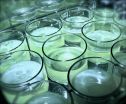(Press-News.org) This news release is available in German.
All multicellular creatures are descended from single-celled organisms. The leap from unicellularity to multicellularity is possible only if the originally independent cells collaborate. So-called cheating cells that exploit the cooperation of others are considered a major obstacle. Scientists at the Max Planck Institute for Evolutionary Biology in Plön, Germany, together with researchers from New Zealand and the USA, have observed in real time the evolution of simple self-reproducing groups of cells from previously individual cells. The nascent organisms are comprised of a single tissue dedicated to acquiring oxygen, but this tissue also generates cells that are the seeds of future generations: a reproductive division of labour.
Intriguingly, the cells that serve as a germ line were derived from cheating cells whose destructive effects were tamed by integration into a life cycle that allowed groups to reproduce. The life cycle turned out to be a spectacular gift to evolution. Rather than working directly on cells, evolution was able to work on a developmental programme that eventually merged cells into a single organism. When this happened groups began to prosper with the once free-living cells coming to work for the good of the whole.
Single bacterial cells of Pseudomonas fluorescens usually live independently of each other. However, some mutations allow cells to produce adhesive glues that cause cells to remain stuck together after cell division. Under appropriate ecological conditions, the cellular assemblies can be favoured by natural selection, despite a cost to individual cells that produce the glues. When Pseudomonas fluorescens is grown in unshaken test tubes the cellular collectives prosper because they form mats at the surface of liquids where the cells gain access to oxygen that is otherwise - in the liquid - unavailable.
Given both costs associated with production of adhesive substances and benefits that accrue to the collective, natural selection is expected to favour types that no longer produce costly glues, but take advantage of the mat to support their own rapid growth. Such types are often referred to as cheats because they take advantage of the community effort while paying none of the costs. Cheats arise in the authors' experimental populations and bring about collapse of the mats. The mats fail when cheats prosper: cheats obtain an abundance of oxygen, but contribute no glue to keep the mat from disintegrating - the mats eventually break and fall to the bottom where they are starved of oxygen.
Paul Rainey, who led the study at the New Zealand Institute for Advanced Study and the Max Planck Institute for Evolutionary Biology, explains: "Simple cooperating groups - like the mats that interest us - stand as one possible origin of multicellular life, but no sooner do the mats arise, than they fail: the same process that ensures their success - natural selection - , ensures their demise." But even more problematic is that groups, once extant, must have some means of reproducing themselves, else they are of little evolutionary consequence.
Pondering this problem led Rainey to an ingenious solution. What if cheats could act as seeds - a germ line - for the next set of mats: while cheats destroy the mats, what about the possibility that they might also stand as their saviour? "It's just a matter of perspective", argues Rainey. The idea is beautifully simple, but counter-intuitive. Nonetheless, it offers potential solutions to profound problems such as the origins of reproduction, the soma / germ distinction - even the origin of development itself.
In their experiments the researchers compared how two different life cycles affected group (mat) evolution. In the first, the mats were allowed to reproduce via a two-phase life cycle in which mats gave rise to mat offspring via cheater cells that functioned as a kind of germ line. In the second, cheats were purged and mats reproduced by fragmentation. "The viability of the resulting bacterial mats, that is, their biological fitness, improved under both scenarios, provided we allowed mats to compete with each other," explains Katrin Hammerschmidt of the New Zealand Institute for Advanced Study.
Surprisingly however, the researchers found that when cheats were part of the life cycle, the fitness of cellular collectives decoupled from that of the individual cells: that is, the most fit mats consisted of cells with relatively low individual fitness. "The selfish interests of individual cells in these collectives appear to have been conquered by natural selection working at the level of mats: individual cells ended up working for the common good. The resulting mats were thus more than a casual association of multiple cells. Instead, they developed into a new kind of biological entity - a multicellular organism whose fitness can no longer be explained by the fitness of the individual cells that comprise the collective" says Rainey.
"Life cycles consisting of two phases are surprisingly similar to the life cycles of most multicellular organisms that we know today. It is even possible that germ-line cells, i.e. egg and sperm cells, may have emerged during the course of evolution from such selfish cheating cells," says Rainey.
INFORMATION:
Original publication
Katrin Hammerschmidt, Caroline Rose, Ben Kerr and Paul B. Rainey
Life cycles, fitness decoupling and the evolution of multicellularity
Nature, 6 November 2014; 515, 75-79 (doi:10.1038/nature13884)
ANN ARBOR, Mich. -- Teens and young adults who get seriously injured in an assault are nearly twice as likely as their peers to end up back in the emergency room for a violent injury within the next two years, a new University of Michigan Injury Center study finds.
The researchers call this repeating pattern of violent injury a reoccurring disease, but their landmark study also suggests potentially powerful opportunities to intervene in ways that could stop the cycle.
The first six months after a young person seeks care for a violence-related injury is an especially ...
New Rochelle, NY, November 6, 2014--Lower-cost 3D printers for the consumer market offer only a limited selection of plastic materials, while industrial additive manufacturing (AM) machines can print parts made of high-performance metals. The application of a novel process called Selective Inhibition Sintering (SIS) in a consumer-priced metal AM machine is described in an article in 3D Printing and Additive Manufacturing, a peer-reviewed journal from Mary Ann Liebert, Inc., publishers. The article is available free on the 3D Printing and Additive Manufacturing website until ...
Does synthetic biology hold the key to manned space exploration of Mars and the Moon? Berkeley Lab researchers have used synthetic biology to produce an inexpensive and reliable microbial-based alternative to the world's most effective anti-malaria drug, and to develop clean, green and sustainable alternatives to gasoline, diesel and jet fuels. In the future, synthetic biology could also be used to make manned space missions more practical.
"Not only does synthetic biology promise to make the travel to extraterrestrial locations more practical and bearable, it could also ...
Berlin, Germany (November, 2014) - The dodo is among the most famous extinct creatures, and a poster child for human-caused extinction events. Despite its notoriety, and the fact that the species was alive during recorded human history, little is actually known about how this animal lived, looked, and behaved. A new study of the only known complete skeleton from a single bird takes advantage of modern 3-D laser scanning technology to open a new window into the life of this famous extinct bird. The study was presented at the 74th Annual Meeting of the Society of Vertebrate ...
Berlin, Germany (November, 2014) - Many large charismatic mammals went extinct at the end of the Ice Age (approx 11,000 years ago), including the Steppe bison, Bison priscus. A recent find in Eastern Siberia has uncovered one of these bison, literally, frozen in time.
The most complete frozen mummy of the Steppe bison yet known, dated to 9,300 years before present, was recently uncovered in the Yana-Indigirka Lowland and a necropsy was performed to learn about how this animal lived and died at the end of the Ice Age. The Yukagir bison mummy, as it is named, has a complete ...
There is no doubt that pregnant and breastfeeding women try to do everything they can to ensure a healthy outcome for their baby, including eating a healthy, well-balanced diet that provides the necessary nutrients for fetal growth and development. In recent years, there has been significant debate about the consumption of fish among pregnant and breastfeeding women.
In June, following a survey that found that the majority of pregnant women do not eat much fish and thus may have inadequate intake of certain omega 3 fatty acids, the Food and Drug Administration (FDA) ...
COLUMBUS, Ohio - The health benefits of over-the-counter curcumin supplements might not get past your gut, but new research shows that a modified formulation of the spice releases its anti-inflammatory goodness throughout the body.
Curcumin is a naturally occurring compound found in the spice turmeric that has been used for centuries as an Ayurvedic medicine treatment for such ailments as allergies, diabetes and ulcers.
Anecdotal and scientific evidence suggests curcumin promotes health because it lowers inflammation, but it is not absorbed well by the body. Most curcumin ...
BOSTON - (November 6, 2014) - Mary R. Loeken, Ph.D., Investigator in the Section on Islet Cell and Regenerative Biology at Joslin Diabetes Center and Associate Professor of Medicine at Harvard Medical School, has discovered a molecular pathway responsible for neural tube defects in diabetic pregnancies. Her latest research findings in this pathway were published in the October issue of Diabetes.
For 20 years, scientists have known of a gene involved in neural tube defects (such as spina bifida), but until now it was not known exactly what causes this gene to malfunctions ...
The modern sequencing techniques have shown that bats can carry a bacterial species previously been shown to cause deadly human infections in USA.
When the research group of Arto Pulliainen at the Department of Biosciences, University of Helsinki, Finland, analyzed an array of bat samples from Finland and UK, one class of identified bacteria turned out to be exceptionally significant. Multilocus sequence analyses of clonal bat Bartonella isolates demonstrated that bats carry Bartonella mayotimonensis. This species has previously been shown to cause deadly human infections ...
MANHATTAN, KANSAS -- A Kansas State University psychological sciences professor is using twin studies to understand the nature versus nurture debate of the workplace: Do genetic factors or environmental factors influence employee proactivity?
His answer: The interaction between the genetic and environmental factors determines why some employees are more proactive than others.
"It's more like nature and nurture rather than nature versus nurture," said Wendong Li, assistant professor of psychological sciences in the College of Arts & Sciences. "It is the reciprocal relationship ...




